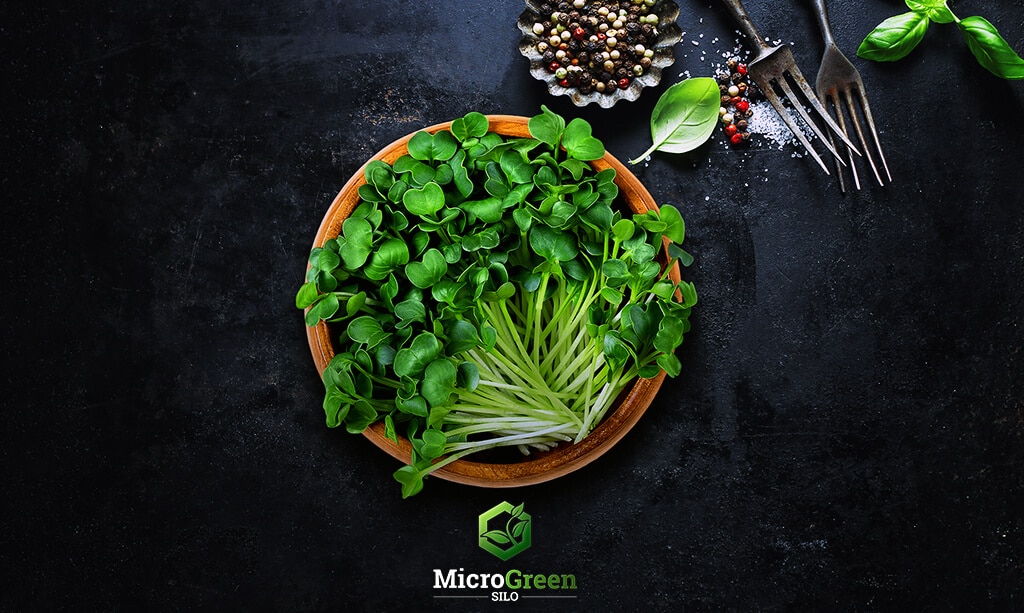
I frequently get asked, what are microgreens? While microgreens are becoming more widely recognized, many are unaware of these tiny wonders. Hopefully, this will answer all of your questions on the subject.
Microgreens are vibrant and delicate young, edible plants harvested at an early stage of development, usually when their initial leaves, known as cotyledons, have formed.
These tiny plants are packed with flavor and vibrant hues, making them popular in meals, salads, and juices. Let’s take a closer look at these micro wonders, exploring their origins, unique characteristics, and the incredible benefits they provide. Let’s get our hands dirty!
Origins Of Microgreens
Taking a historical perspective is imperative when discussing modern microgreens. Thus. Before we consider their contemporary usage today. Let’s investigate their beginnings by exploring the vegetation that our ancestors grew and consumed. Let us begin!
History shows that civilizations have consumed sprouted grain and young seedlings for centuries.
Although “microgreens” is a relatively new term coined by Chef Craig Hartman in 1992 (read who invented microgreens here), ancient civilizations documented the consumption of young, tender plants and sprouts throughout history.
Ancient China
The first sprouted seeds were produced in China in 2737 BC when Emperor Shennong promoted sprouts as a powerful remedy. The Chinese have been consuming sprouts and microgreens for over 4755 years! I recommend you check Emperor Shennong out – he was a pure badass!

Ancient Persians
Sprouting was also a popular activity in ancient Persia (modern-day Iran). Ancient Persians consumed wheat and barley sprouts for their health benefits. They also used sprouted seeds and grain in their world-famous “Essene bread.”
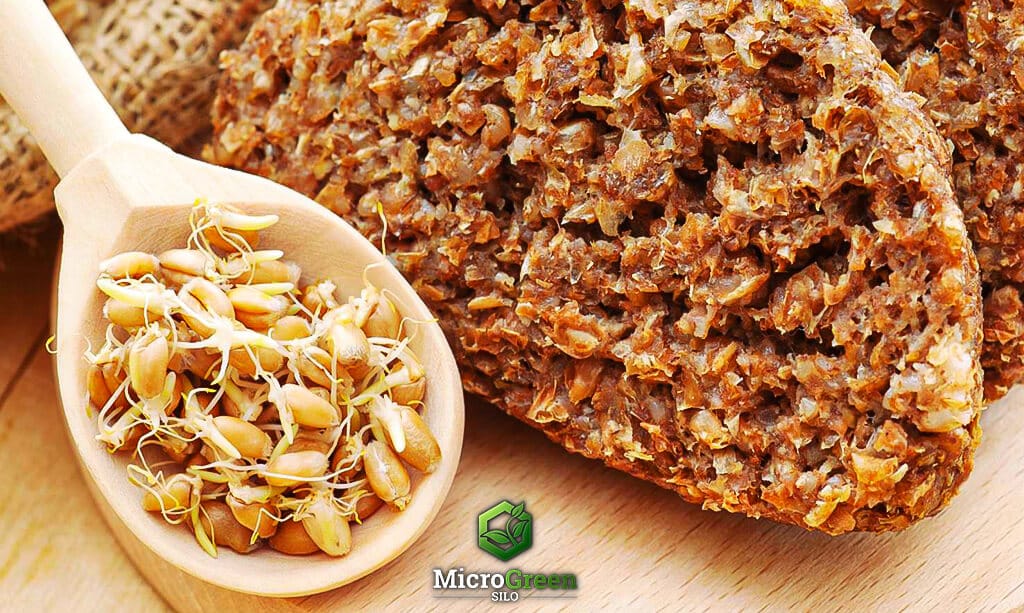
But Microrgeens as we know them today initially appeared on menus during the mid-1990s. Some sources say they first appeared in San Francisco, California, in the early 90s.
What we know for a fact is that microgreens started gaining popularity in early-2015 based on Google Trends and peaked in April 2020, and it doesn’t look like this trend is going to tank. Check this chart out.
Now, let’s discuss what microgreens are, their unique characteristics, and the incredible benefits they provide!
What Are Microgreens?
So what are microgreens!? They’re tiny vegetable or herb seedlings harvested in their early growth stages, typically around 1-3 inches tall after their cotyledons (first true leaves) develop. They’re smaller and more delicate than baby greens but larger than sprouts.
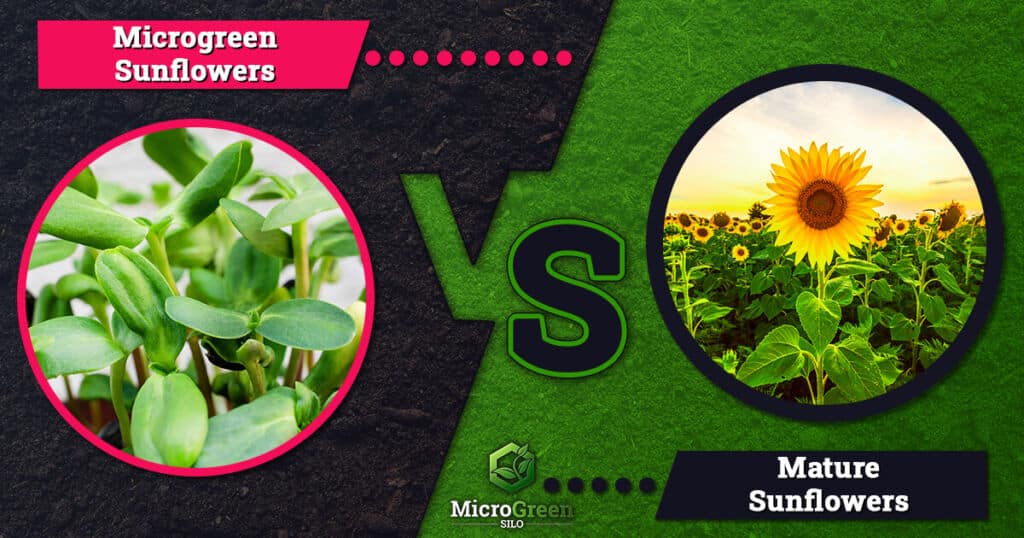
Given enough room, care and patience, microgreens will naturally progress into mature plants if left alone. A chart outlining bean growth stages from sprouting to bearing fruit is presented below as an example of this development cycle.
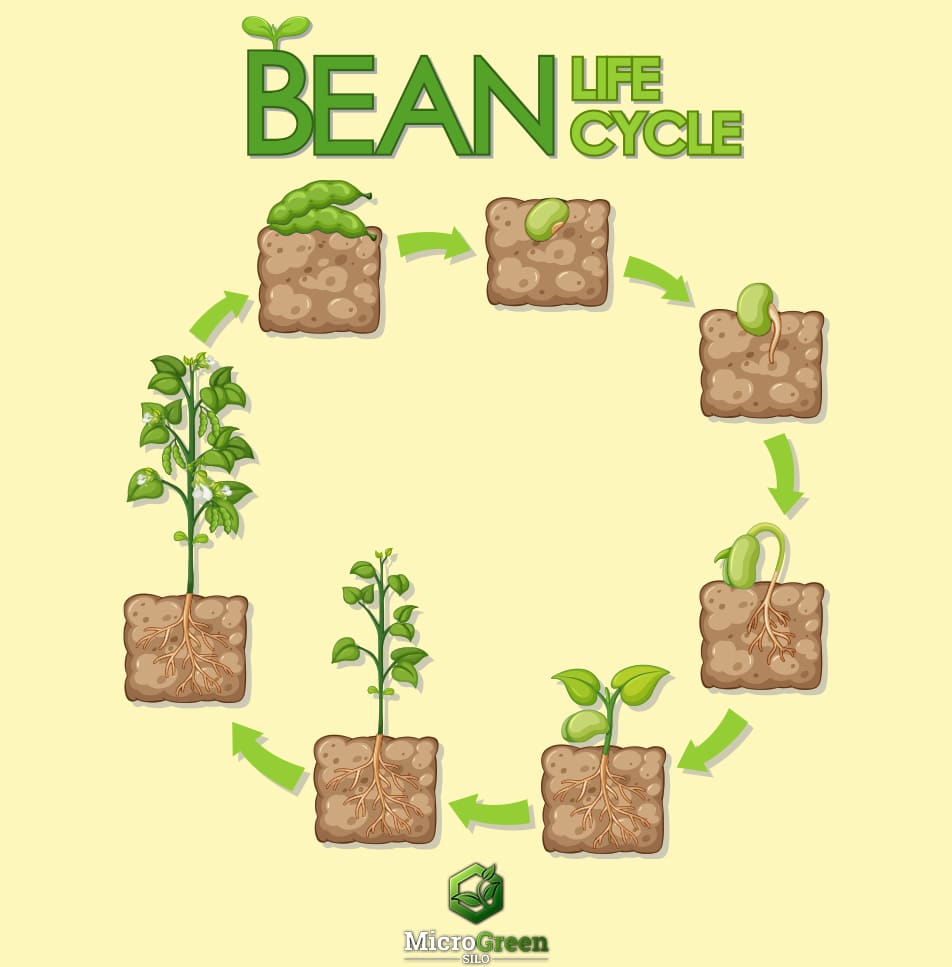
The chart shows a bean seed producing a radicle that burrows into the soil, searching for water and nutrients. The cotyledon is pushed above the ground to start photosynthesis. The bean at this stage is considered a microgreen. Allowing the bean to mature will produce flowers and fruit, at which point the cycle repeats.
Now if you’re still pondering “what are microgreens?” the simple answer is they’re young seedlings that are harvested after the cotyledons have formed, but before the true leaves emerge. Let’s move on to Hypogeal and Epigeal germination types.
Hypogeal Vs Epigeal Germinating Seeds
Here’s a plant anatomy diagram depicting the various parts of a mung bean microgreen (Vigna radiata). Mung beans are epigeal geminating plants meaning that the seed grows above the ground after germination. Here’s an example of what that looks like.
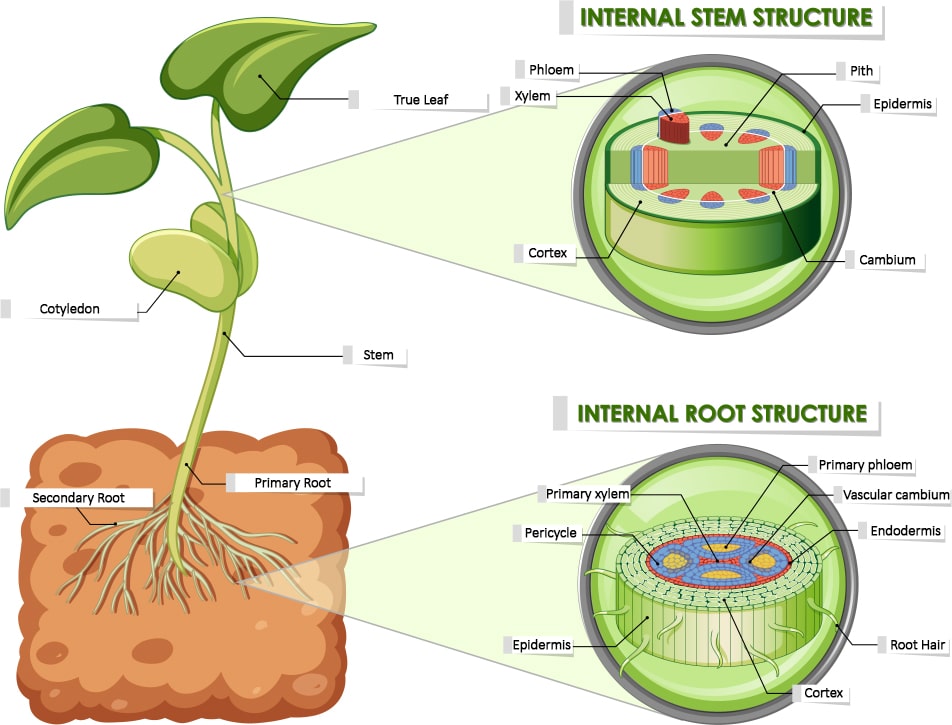
However, in hypogeal germination, the seed stays below the ground after germination. The first part to emerge is the embryonic root (seed radicle). The radical extends downwards into the soil to anchor the plant and absorb water and nutrients. Then, the shoot and cotyledons emerge and reach towards a light source.
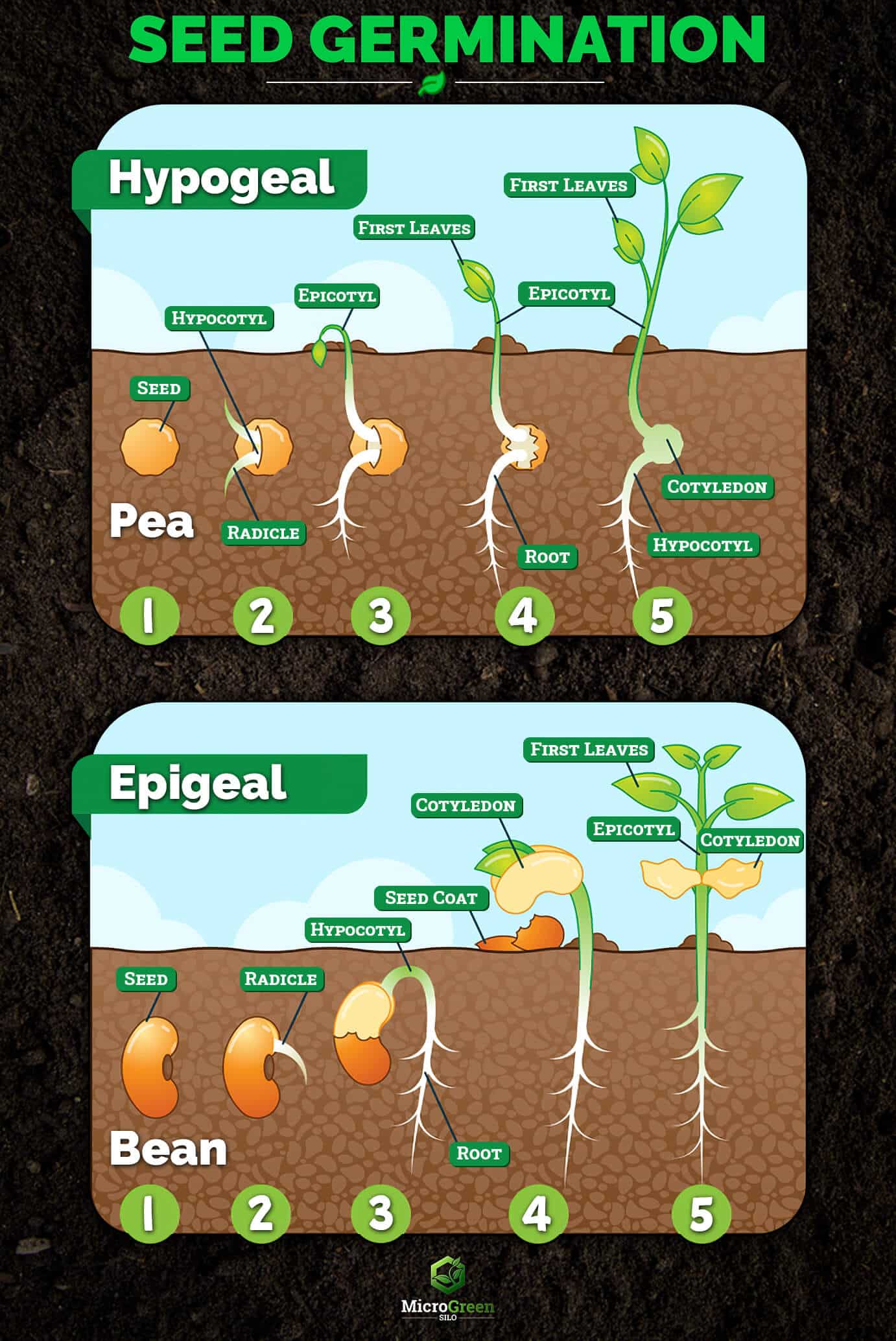
Hypogeal & Epigeal Seeds
Here’s a table of various hypogeal and epigeal seeds.
| Hypogeal | Epigeal |
| Onion | Pea |
| Beets | Bean |
| Leek | Sunflower |
| Kohlrabi | Swiss Chard |
| Broccoli | Radish |
At this point, you should have a solid understanding of basic botanical anatomy, including identifying seeds as either hypogeal or epigeal. Moving forward, we will delve deeper into the topic of microgreens!
Microgreens are known for their concentrated flavors, rich colors, and delicate textures. Let’s analyze their ten key characteristics.
Microgreen Characteristics
Microgreens are distinguishable by the following ten characteristics.
Size
Microgreens are ready for harvest in their early growth stages, typically around 1-3 inches tall after their cotyledons (embryo leaves) develop. The height of microgreens generally falls within the range of 1 to 3 inches.
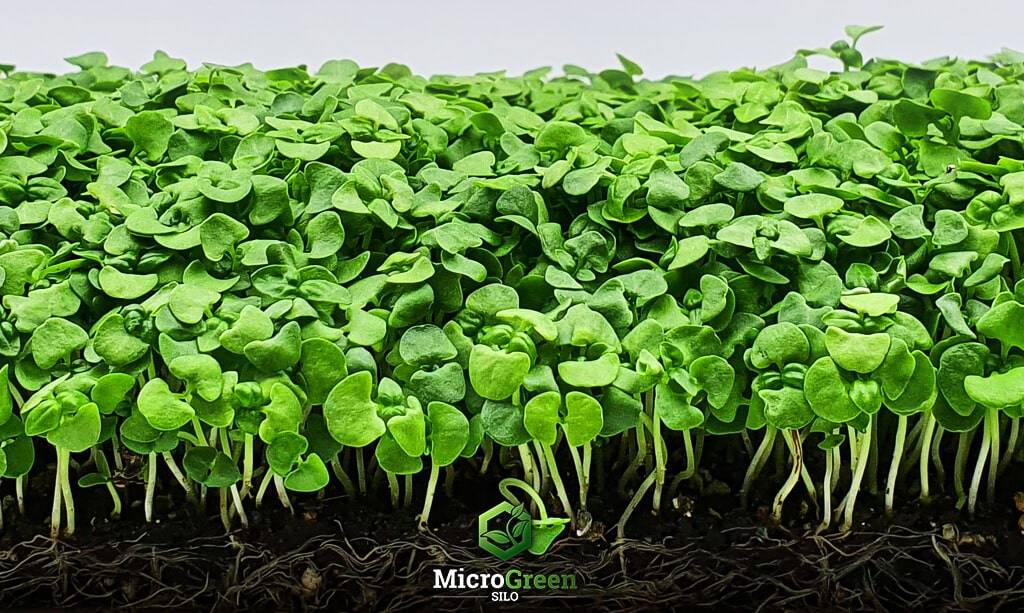
Flavor
Microgreens have a robust and intense flavor. They taste similar to their mature counterparts but are more complex yet delicate.
Color
Microgreens have bright and beautiful colors. They range from vibrant reds, rich greens, and bright yellows – depending on the microgreen type being grown.
Texture
Microgreens are well-known for their distinct and delicate texture that varies depending on the type of microgreen. Some are tender and leafy, while others are juicy/crunchy.
Nutritional Value
Studies have shown that these little plants can contain up to 40x nutrition compared to their mature counterparts. They’re bursting with vitamins, minerals, and antioxidants.
Growth Cycle
Most microgreens have a short growth cycle, some as quick as 5-6 days, such as radishes! Other types need 6-12 days of sowing the seeds. Such rapid growth cycles are why microgreens are so popular and fun to grow.
Versatility
You can grow microgreens from many different vegetable and herb seeds, allowing for a diverse range of flavors, textures, colors, and mixes. Some common types include radish, sunflower, arugula, peas, cilantro, and many more!
Culinary Uses
Microgreens have become extremely popular in fine dining establishments due to their unique flavors and appearance. In fine dining, they’re popular as garnishes, inside wraps (my favorite), sandwiches, salads, and many other dishes or drinks.
Growth Difficulty
Most microgreens are grown in controlled environments. As their life cycle is short, the equipment required to cultivate them is minimal, enabling urban gardeners to grow them effortlessly year-round.
Short shelf life
Because of their fragility, microgreens have a shorter shelf life than fully-grown vegetables. With proper care during harvest, extending the shelf life can be achieved.
How are microgreens grown?
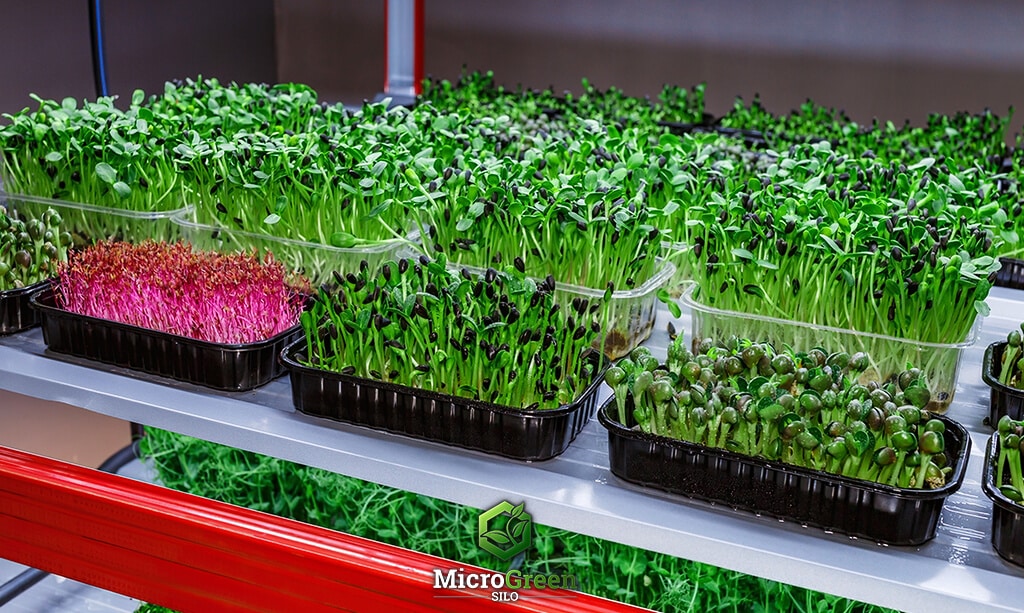
The conventional practice for growing microgreens involves trays called flats that utilize soil or potting mix as a basis. Despite this widely adopted approach, growers have discovered various other methods worth exploring; such as planting seeds in eggshells or nutrient-rich hydroponic systems. Here’s a table with various cultivation methods available. I personally favor the traditional route of using soil as it yields impressive results.
| Cultivation Method | Description |
| Tray/Flats – Soil-based | Growing microgreens in trays/flats using soil or potting mix. Most poplar method. |
| Coco coir | Using coconut coir as a growing medium. Also a popluar method. |
| Hemp mats | Sprouting microgreens on mats made of natural materials like hemp. |
| Paper towels | Sprouting microgreens on damp paper towels or cloth, which provide moisture and support for germination. |
| Mason Jars | Growing microgreens in containers like mason jars, allowing for easy observation and maintenance. |
| Hydroponics | Growing microgreens in a nutrient-rich water solution without soil. |
| Aquaponics | Combining hydroponics with aquaculture, where fish waste provides nutrients for microgreen growth. |
| Aeroponics | Growing microgreens using aeroponic or fogponic systems that deliver nutrients directly to the roots without a growing medium. |
| Empty Egg-shells | Fun for kids, fill the empty shell halves with soil. |
What is the difference between microgreens & sprouts?
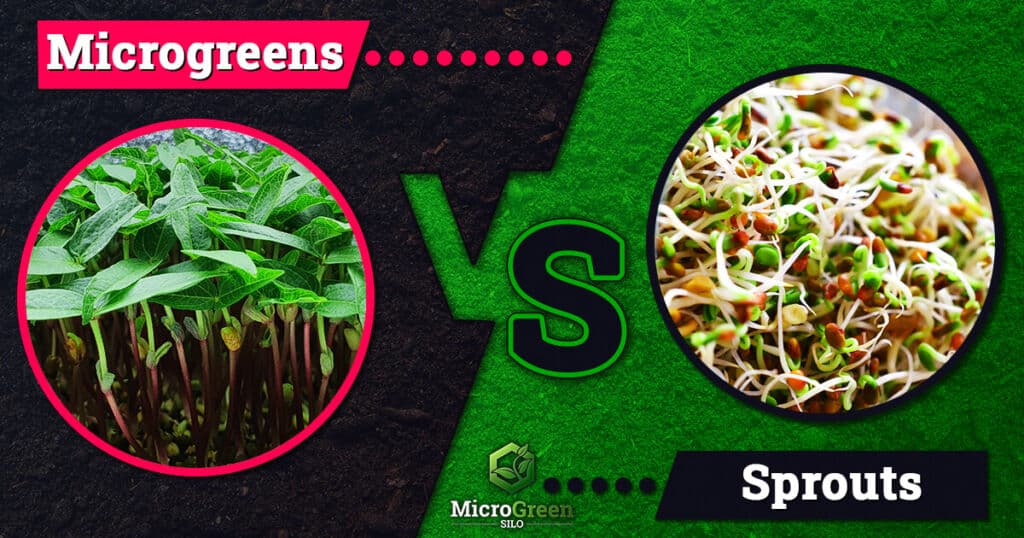
Both microgreens and sprouts are young vegetable seedlings. However, several differences set them apart.
- Grow Method: Sprouts are commonly grown in mason jars by soaking the seeds and rinsing them multiple times throughout the day until seeds sprout. Microgreens, however, are grown in soil, soil substitutes, or hydroponically. Also, microgreens require light exposure for leaf development.
- Growth Stage: Microgreens are ready for harvest when their cotyledons have developed and the first true leaves about to emerge. Sprouts are harvested after germination when the stems and roots are still underdeveloped.
- Plant Part Consumption: Microgreen cotyledons, leaves, and stems are for consumption, while the seeds and roots are generally scrapped or composted. Sprouts are different. You can consume everything, including the stems, roots, and seeds. Just DON’T drink the water!
- Flavor & Texture: Sprouts are crispy and crunchy, and their flavor is often milder and slightly nutty. Microgreens, on the other hand, have more developed flavor profiles and a tender texture. Microgreens can range from sweet and mild to tangy or spicy
Do Microgreen seeds differ from “normal” seeds?
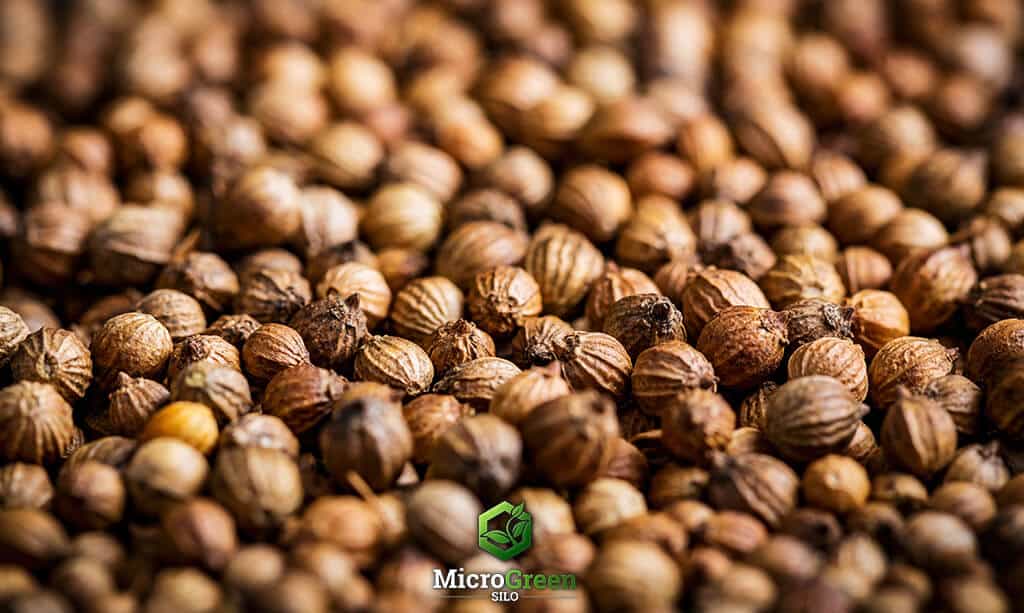
People frequently ask me, “Are microgreen seeds different from regular seeds?” The simple answer is no – microgreen seeds are no different from any other seed. They’re just regular seeds, the only aspect that can differ in seeds is if they’re organic, heirloom, hybrid, or genetically modified organisms (GMO).
So what are organic, heirloom, hybrid, and GMO seeds?
Organic Seeds: Organic seeds come from plants grown following organic farming methods. Organic methods strictly exclude GMOs, pesticides, herbicides, and synthetic fertilizers.
Heirloom Seeds: Open-pollinated plants passed down from generation to generation are known as heirloom or heritage seeds. Heirloom varieties are at least 50 years old, seldom accessible in the commercial seed trade, and have been maintained and kept true in particular regions.
Tomato seeds are a classic heritage example, as they often offer superior flavor, color, or texture for home gardens. However, they may lack the storing ability (shelf life), uniform color and shape, disease resistance, or early maturity required for commercial viability.
Hybrid Seeds: Hybrid plants are created by crossing two different plant varieties and then collecting and cultivating the offspring with desired qualities, such as larger fruit, disease resistance, or other properties.
Hybrids often have sacrificed flavor for other more industrial benefits such as larger fruit, thicker skin to withstand mechanical harvesting, or a longer storage life.
Genetically Modified Organisms (GMOs): A GMO plant is one that has been genetically modified using molecular genetics techniques such as gene cloning and protein engineering. GMO crops are plants that have the insecticide Bt incorporated into their genetic composition to make them resistant to specific pests.
What are microgreens used for?
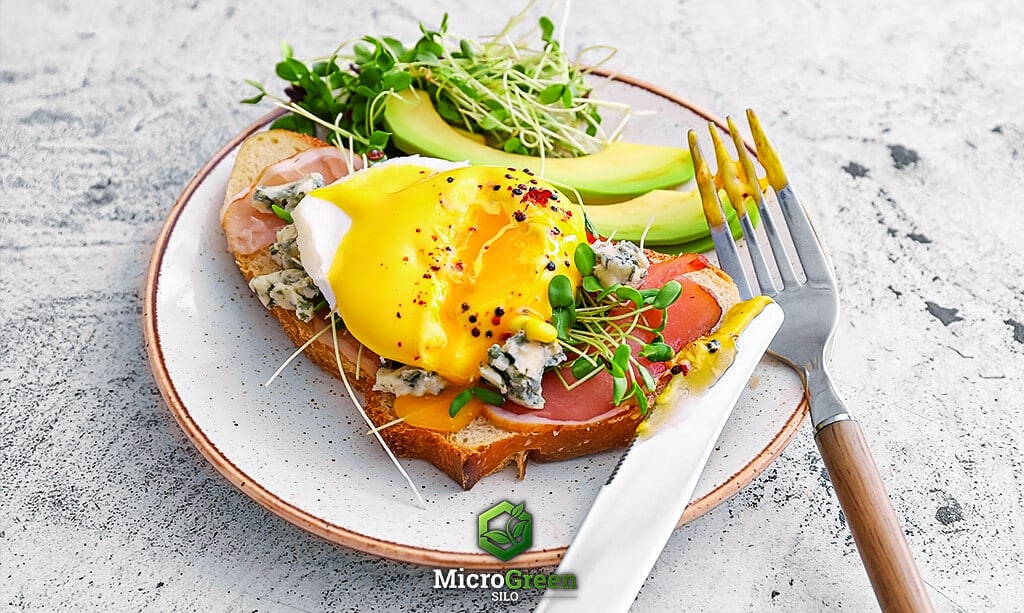
Because of their wicked flavors, vibrant colors, and nutritional advantages, they serve several purposes in culinary applications. Here are some popular uses for microgreens:
Garnish: Microgreens not only look beautiful as garnishes but also offer a unique burst of flavor to your dishes. You can easily sprinkle them over salads, soups, sandwiches, and main courses to add some texture and vibrant colors for a more appetizing presentation.
Salads: It’s no secret that many people love incorporating microgreens into their salads and wraps. With their fresh. Flavorful element. They provide a unique taste sensation and gentle crunch that adds depth to any dish.
Burgers, wraps & sandwiches: The inclusion of microgreens in sandwiches and burgers is a highly recommended practice. It not only enhances the taste but also elevates the meals’ texture and flavor profile to another level. By adding microgreens these handheld meals would acquire an extra layer of sophistication providing a more refined gustatory experience.
Juices & smoothies: Did you know that adding mild flavored microgreens such as pea shoots or sunflower greens to your smoothies or juices can significantly increase the nutritional content? These delicious and nutritious greens contribute to the overall flavor of your beverage while boosting its nutrient density.
Stir-fries and sautés: Never settle for mundane dishes again; amplify their flavors by experimenting with microgreens! In particular, try incorporating varieties like radish or mustard greens into stir-fries and sautés to unlock unparalleled tastes in your meals. With minimal effort involved, these greens significantly augment the aromatic palette while providing an enjoyable crunch and a hint of spice when lightly cooked.
Culinary experimentation: Microgreens are a beloved ingredient among chefs and home cooks seeking to push the boundaries of their culinary abilities. From sweetly subtle to boldly spicy, these small yet mighty greens provide endless opportunities for experimentation when it comes to flavor profiles and presentations.
Microgreens have become increasingly popular not just for their aesthetic value but also for their impressive nutritional properties. By adding these small greens to your meals you can easily amp up the nutrient density without sacrificing taste or presentation.
Microgreens Benefits
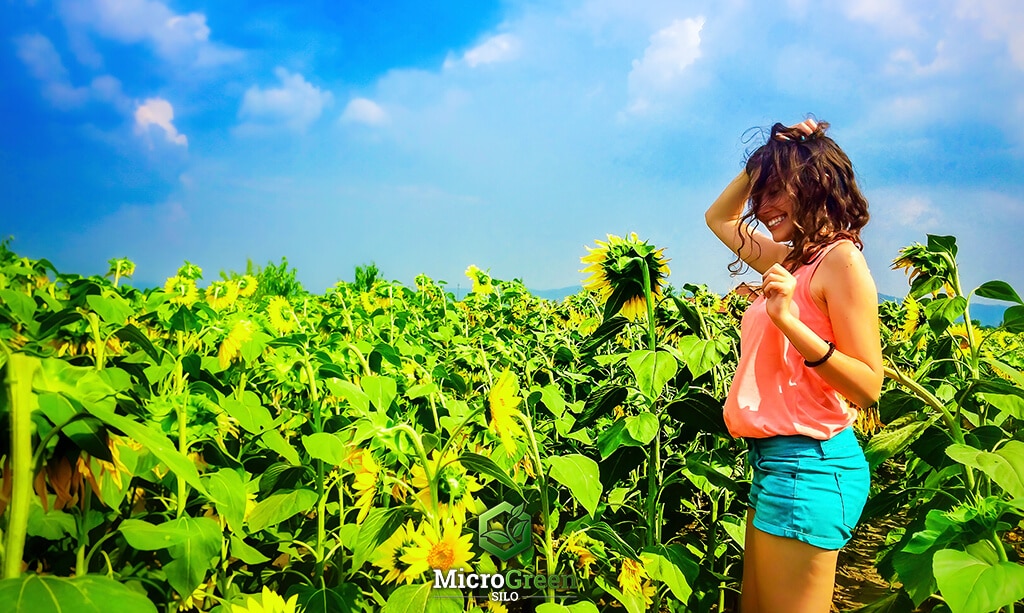
For those looking to improve their dietary habits or the visual appearance of their plate microgreens provide a wealth of advantages. Consider some of the primary benefits that they offer:
Nutrition: With its wealth of essential vitamins, minerals, and antioxidants. Microgreens have become an increasingly popular source of nutrition nowadays.
For example, multiple scientific sources confirm the fact that they can potentially offer much higher concentrations of these vital components in comparison to the fully grown plant counterpart. In addition. Microgreen varieties such as those rich in Vitamin C, E, and K alongside beta carotene.
Antioxidants: The powerful antioxidant properties found in microgreens offer numerous benefits. Particularly in safeguarding the body from damaging free radicals. By reducing oxidative stress. Antioxidants actively contribute to enhancing overall health.
Flavor: Microgreens. Though small in size. Have the ability to pack a powerful punch of flavor and fragrance. These greens can elevate the taste profile of dishes. Bringing about nuances and richness that enhance the overall culinary experience.
Culinary versatility: If you’re looking for an easy way to elevate your meals’ flavor profile while adding some color to it too – microgreens could just do the trick! Not only are these tiny greens visually appealing with their bright hues and delicate textures but also perfect for dishes like salads and sandwiches as well as stir-fries or smoothies.
Quick and easy to grow: Microgreens have a remarkable growth cycle reaching the stage of readiness for harvesting only 6-21 days after planting. This convenient feature enables home growers and city folks with limited gardening space to experience the joy of cultivating these greens in their own homes.
Sustainable: You’d be glad to know that cultivating them requires minimal resources like water and space yet delivers maximal output in terms of health benefits. Growing these greens at home not only offers convenience but also helps reduce food waste by optimizing seed utilization.
Potential health benefits: The current data on this topic is inconclusive; however there have been preliminary signs of promising results which suggest adding microgreens into your diet could prove valuable for your overall health.
However, it is critical to mention that further scientific research is required to better understand microgreen health claims.
In short, microgreens present a range of nourishing benefits and bold flavors. Their adaptability in various culinary creations adds excitement to any dish. Adding these power-packed greens to your daily diet can enrich your overall well-being.
Conclusion
Its hard not to be impressed by what microgreens have brought into the world of culinary arts. These tiny vegetable and herb seedlings offer an explosion of flavors along with vibrant colors and essential nutrients; all this within just miniature versions!
If you’re looking for ways to make your dishes more visually appealing while increasing their nutritional value. Then look no further than microgreens. The unique flavor profiles that come from these tiny plants have earned them a rightful place in gourmet cuisine.
As their demand increases farmers and individuals alike are making sure to cultivate them consistently all year round. So why not join those who see how special these little seeds are?
Microgreens will undoubtedly elevate any dish they go into – salads, sandwiches or anything else – creating gorgeous textures as well as great taste profiles that will take your food game up several notches!
Let me know in the comments if you plan on growing your own microgreens, or if you need any help feel free to reach out.
And remember, Keep Your Hands In The Dirt!
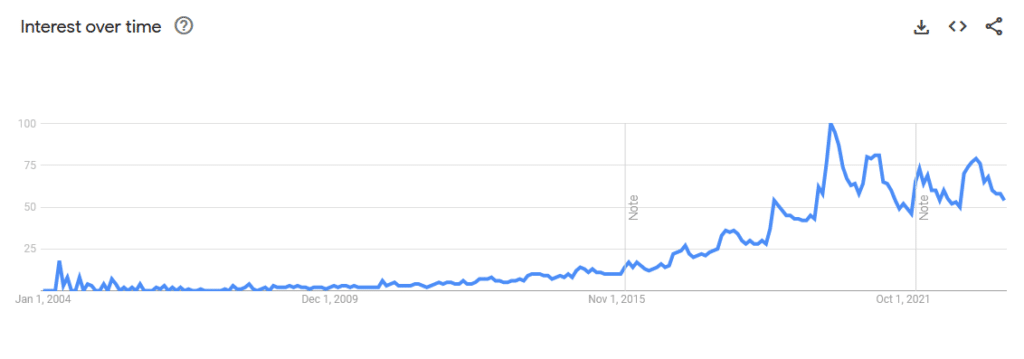



Comments (2)
The article is very thorough and interesting; knowledge should be shared. However, it is necessary to do it in an organized and correct manner, in a sequence. I appreciate it. Interestingly, this industry has indeed been developing since the time of primitive humans. They just didn’t leave us knowledge about it.
I have read only a part of the article and am impressed by your knowledge. We are also developing this direction on our continent, which is large and glorious, much like your country.
Good luck to you.
Thank you for your thoughtful and encouraging comment. I’m glad you found the article interesting, and I appreciate your recognition of the importance of sharing knowledge! I’m always open to further discussions and sharing insights. Best of luck to you as well in your endeavors. And remember, keep your hands in the dirt!